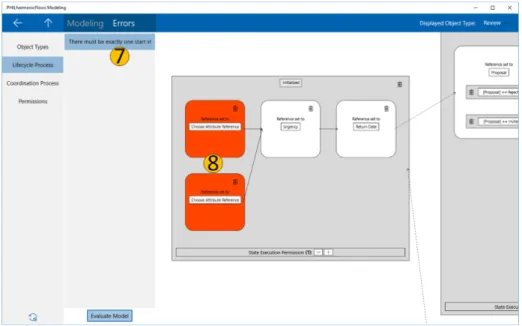A Modeling Tool for PHILharmonicFlows Objects
and Lifecycle Processes
Sebastian Steinau, Kevin Andrews, and Manfred Reichert Institute of Databases and Information Systems, Ulm University, Germany
{rstname.lastname}@uni-ulm.de
Abstract. As opposed to contemporary activity-centric, process-aware information systems (PAIS), for which a multitude of concepts and im- plementations exist, there is only a very limited number of PAIS imple- menting data-centric, artifact-centric or object-aware approaches. This demo paper presents the implementation of a modeling environment for the object-aware approach to business process management. Our imple- mentation is based on the PHILharmonicFlows framework, which allows for the denition and execution of business object models. The current implementation of the modeling environment supports the modeling of objects, their attributes as well as relations to other objects. Further- more, it allows modeling object lifecycle processes, which dene the run- time behavior of the various objects. Finally, the modeling environment features a simple app design, reducing complexity for process modelers while still supporting all features of PHILharmonicFlows.
1 Introduction
Increasing exibility in process management and execution has been broadly dis- cussed in literature in recent years [5]. While most research has focused on the exibility of traditional activity-centric process execution, a number of entirely new process management paradigms have emerged [2,3,4]. Their focus lies more on the data or cases involved in a process and less on the strict ordering of ac- tivities in a single process model. One of these paradigms is object-aware process management, which takes the business objects present in real-world processes as the basis for composing an executable process model, which, itself, comprises models for each object, as well as its lifecycle during process execution and its data. By creating processes revolving around largely independent objects, object-aware processes, in many cases, allow for greater exibility compared to activity-centric processes [4].
As the concept of object-aware process management is sophisticated and requires a shift in perspective and thinking, when creating the modeling envi- ronment for object-aware processes, our main goal was to reduce complexity for users to a minimum. We consider this a prerequisite for future studies of the paradigm, as participants should be able to collaboratively model object-aware
processes without having vast amounts of prior knowledge. We achieve this goal by using a simplistic app design as well as real-time verication. Real-time veri- cation helps reduce the diculty of modeling as it can guide users, preventing them from modeling defective processes. Furthermore, the modeling tool should be extensible, to support future conceptual additions, such as schema evolution and process variants.
The tool we present in this paper1uses the PHILharmonicFlows implemen- tation of object-aware process management at its core, thereby allowing for the graphical creation of process models that run on the existing PHILharmon- icFlows runtime environment [1]. As we are currently in the process of com- pletely restructuring the architecture of the PHILharmonicFlows engine to cre- ate a highly scalable distributed process execution architecture, an additional challenge was to ensure that the modeling environment as well as its collabo- rative modeling and real-time verication capabilities are compatible with both the current client-server architecture, and the new distributed architecture.
2 Modeling Objects and Relations
The object-aware approach to process modeling utilized by the modeling tool can be illustrated using a comprehensive scenario (cf. Example 1).
Example 1. Simplied recruitment process
In the context of recruitment, applicants may apply for job oers. The overall process goal is to determine the applicant best suited for the job. To evaluate an application, reviews need to be performed. Depending on the concerned de- partment, the number of reviews may dier. Department employees write the reviews and either reject the applicants or suggest inviting them for an inter- view. In the meantime, more applications may have arrived, for which further reviews are required. This allows for the evaluation of dierent applications in parallel. If the majority of reviews are in favor of an application, the applicant is invited for an interview, in which he may be hired or rejected. Finally, when one applicant is hired, all other applicants shall be rejected.
At design time, PHILharmonicFlows uses various types, which serve as tem- plates to create instances at runtime. As a rst step to modeling, it is necessary to identify the object types involved. These are directly derived from the busi- ness objects and persons involved in the real-world process. In Example 1, object types include Job Oer, Application, Review, and Interview. Employee is a user type, a special case of an object type representing a person. Each object type has a set of attribute types, describing the data of the corresponding objects. The attribute types are primitives, as they are required for the generation of indi- vidual form elds at runtime. An example attribute type could be Comment, a String dened in the Review object type. Finally, each object type may be con- nected other object types with relation types, allowing their logical association at runtime. Together, object types and relation types form the data model.
1 A screencast is available at https://vimeo.com/222018637
Figure 1 illustrates the creation of the data model related to the example.
The data model comprises object types Employee, Job Oer, Application, Review and Interview and is shown in main area 1. On the left 2, all modeling elements available in the given context are shown. The data model is expanded by dragging a modeling element and dropping it onto the main area. The edges representing the relation types can be created by connecting object types with a simple mouse gesture. The layouting of the data model graph is done automatically, i.e., users need not concern themselves with layouting.
Fig. 1. Object and relation type modeling view
In the right-hand sidebar 3, object types and relation types may be cong- ured after selecting them in the main area. Figure 1 shows the attributes of the Review object type in the attributes tab. The existing attributes can be altered or deleted and new attributes may be added.
3 Modeling Lifecycle Processes
Each object and user type is required to have a lifecycle process (cf. Fig. 2).
As lifecycle processes in object-aware process management are data-driven, they describe which attributes need to have assigned values before an object may change its state. States 4, in turn, become necessary to coordinate the processing of an object with the processing of others based on their current states. Within states, steps 5are used to require an attribute value at runtime. Each step is assigned to an attribute type and connected to other steps by transitions 6, thereby determining the order in which values for the various attributes are required at runtime, i.e., the logic of the corresponding electronic form.
Fig. 2. Lifecycle modeling view
The lifecycle modeling view (cf. Fig. 2) is arranged analogously to the object and relation modeling view (cf. Fig. 1), thereby ensuring a familiar user interface for all parts of the modeling tool. The right-hand sidebar is not displayed, but opens upon selecting an element in the main area, allowing for its conguration.
Overall, the modeling tool aims at providing support for the complex model- ing concept of PHILharmonicFlows in as simple a fashion as possible. All mod- eling actions are immediately synchronized to the PHILharmonicFlows server for immediate verication and to allow for collaborative modeling. Immediate verication and feedback helps users to not model incorrect processes.
4 Model Verication
Model verication is necessary to prevent incorrect process models from being deployed to the PHILharmonicFlows runtime environment. The verication is di- vided into dierent verication components, each checking one aspect of a model, e.g., graph acyclicity or steps without outgoing transitions. The separation of verication into individual components becomes necessary, as verication of the entire data model after every modeling action is not feasible. Immediate verica- tion, therefore, only uses a subset of all available verication components. These verication components provide meaningful error messages, which are necessary for guiding the user through the complexities of PHILharmonicFlows process modeling. Figure 3 shows an error message for multiple start steps in a state 7. Furthermore, upon selecting the error message, the involved process elements in the main area are marked to help the user pinpoint the error location 8. Prior to deployment, a full verication with all components is required.
Fig. 3. Error message and colored modeling elements
5 Summary and Outlook
The modeling tool presented in this paper is a rst step in our ongoing eort to make modeling object-aware processes feasible without needing an in-depth knowledge of the entire object-aware concept. Furthermore, the tool oers a simple user interface with real-time model verication feedback while modeling.
Without such tooling support, modeling an object-aware process can be compli- cated, as changes may impact entirely other parts of the data model. Finally, the modeling environment is extensible with further capabilities, as necessary for our future research into schema evolution and variability of object-aware processes.
References
1. Andrews, K., Steinau, S., Reichert, M.: A Runtime Environment for Object-aware Processes. In: BPM Demo Session (BPMD). CEUR Workshop Proceedings (2015) 2. Haddar, N., Tmar, M., Gargouri, F.: Opus Framework: A Proof-of-Concept
Implementation. In: IEEE/ACIS 14th Int'l Conf. Computer and Information Science (ICIS). pp. 639641 (2015)
3. Heath, T.F., Boaz, D., Gupta, M., Vaculín, R., Sun, Y., Hull, R., Limonad, L.:
Barcelona: A Design and Runtime Environment for Declarative Artifact-centric BPM. In: 11th Int'l Conf. on Service-Oriented Comp. (ICSOC). pp. 705709 (2013) 4. Künzle, V., Reichert, M.: PHILharmonicFlows: Towards a Framework for
Object-aware Process Management. Journal of Software Maintenance and Evolution: Research and Practice 23(4), 205244 (2011)
5. Reichert, M., Weber, B.: Enabling Flexibility in Process-aware Information Systems: Challenges, Methods, Technologies (2012)


